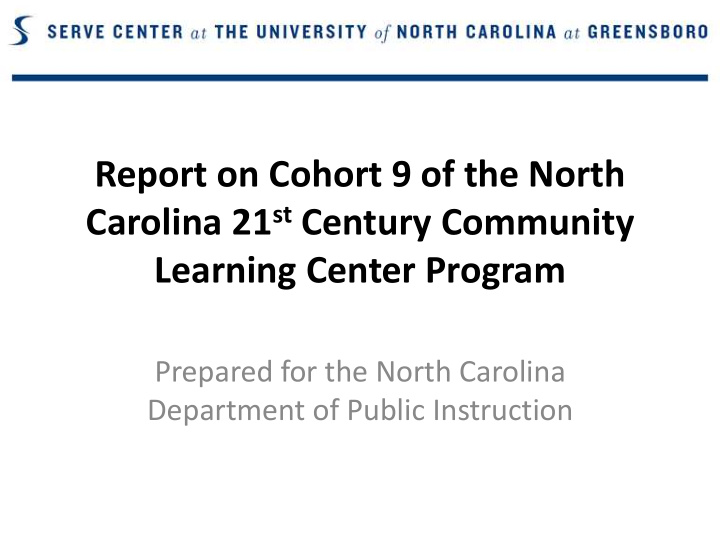



Report on Cohort 9 of the North Carolina 21 st Century Community Learning Center Program Prepared for the North Carolina Department of Public Instruction
Three Study Goals Goal Analysis Descriptive statistics for grantees, 1. Describe Cohort 9 grantees, centers, centers, and participating students students served, and attendance levels (2012-13) Average reading and math EOG change 2. Describe extent of year-to-year change from 2012 to 2013, relative to state on reading and math EOG tests for Cohort population change in standard deviation 9 students (grades 4-8) units 3. Describe variation in centers’ average year-to-year change in reading and math Average year-to-year change in standard EOG test scores deviation units across Cohort 9 centers
Study Goal 1 Describe the grantees, centers, students served, and attendance levels
Cohort 9 Grantees (85 total) Average of 2 centers per grantee Average of 178 students served per grantee Average of 76 students per center Average Average Number of Grantee Type Number of Number of Grantees Centers Students Community Based Organizations 34 2 139 School Districts 23 3 265 Faith Based Organizations 15 1 108
2012-13 Cohort 9 Students • 15,089 reported as participating by 85 grantees 64% elementary, 27% middle, 9% high school 56% black, 22% white, 16% Hispanic Percent below proficient in 2012 49% for reading EOG 30% for math EOG By type of grantee 31% served by community based organizations 40% by school districts 11% by faith-based organizations
2012-13 Attendance Reported Attendance for all Cohort 9 students 21% attended program less than 30 days 47% attended program between 30 and 89 days 32% attended 90 or more days Average attendance across 198 centers 6% of centers had an average attendance rate less than 30 days 73% of centers had an average attendance rate between 30 and 89 days 21% of centers had an average attendance rate above 90 days
Study Goals 2 and 3 2. Describe extent of year-to-year change on reading and math EOG tests by Cohort 9 students 3. Describe variation in centers’ average year-to-year change in reading and math EOG test scores
How much year-to-year change on state tests relative to the state population did Cohort 9 students realize? Interpretation of year-to-year (2012 to 2013) change scores: Zero: Year-to-year change was the same as the state year- to-year change. Positive: Year-to-year change was m ore than the state year-to-year change. Negative: Year-to-year change was less than the state year-to-year change. Limitations: for descriptive purposes only, not for judging program success
Reading and Math EOG Slightly less year-to-year change compared to the overall change for all students in NC
Disaggregated by Proficiency Levels Level I students had greater year- to-year change than the state population More pronounced for math than reading Level II math had a year-to-year change value of 0 Levels III and IV had less change than the state
Reading EOG: Variation Across Centers 88% of centers had less average change than the state population 12% had as much or more average change
Math EOG: Variation Across Centers 75% of centers had less average change than the state population 25% had as much or more average change than the state
Future Considerations • Two possible purposes to continue analyses of student outcome data in subsequent years: Identify centers with average year-to-year changes 1. on key student outcomes greater than the state population and describe promising practices Provide feedback to grantees about their centers’ 2. average year-to-year changes on key student outcomes (to encourage discussions about ways to improve center programs)
Recommend
More recommend